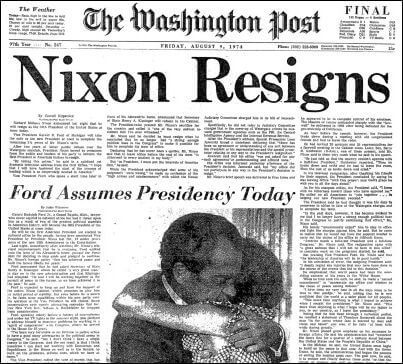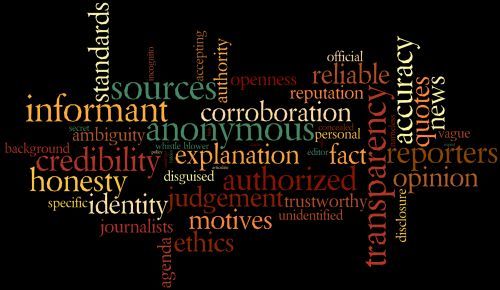This article is part of a series on news literacy, to educate readers to better judge the reliability of news reports and other sources of information.
In an ideal world, the people sharing information with reporters would stand behind what they say in the strongest way possible – by going on the record and being quoted by name.
Identifying a source is a form of media transparency allowing readers to form their own judgment while forcing sources to hold to a higher standard of honesty.
 But life’s not ideal. World leaders, international diplomats, military brass, intelligence figures, judges, lawyers, activists, municipal movers and shakers, political hacks, policy wonks, professors, business executives, athletes, Hollywood personalities, agents, advisers, entourages, friends, relatives and hangers-on don’t always put their name behind their statements.
But life’s not ideal. World leaders, international diplomats, military brass, intelligence figures, judges, lawyers, activists, municipal movers and shakers, political hacks, policy wonks, professors, business executives, athletes, Hollywood personalities, agents, advisers, entourages, friends, relatives and hangers-on don’t always put their name behind their statements.
To a certain extent, we understand that reality.
We accept that sources aren’t always in a position to talk on record, even though some of the reasons put us all on a slippery slope. A source may have a job to protect, a reputation to preserve, a policy to promote or prevent, a client to represent, a business deal at stake, an axe to grind or a personal history to cover up. Being identified can even endanger lives.
But sharing what they know may still be in the public interest.
Join the fight for Israel’s fair coverage in the news
All this makes anonymous sources a necessary evil. When handled in an ethical manner, they grease the wheels of journalism. Think “Deep Throat,” later identified as the FBI’s number two man, Mark Felt, who guided Washington Post reporters Bob Woodward and Carl Bernstein through the Watergate scandal. Thanks to their work, corruption at the highest levels of power was exposed and president Richard Nixon was forced to resign.

But not every reporter is Bob Woodward or Carl Bernstein, not every every nameless source is Mark Felt, and not every story is Watergate.
So as news consumers, what are we to do when we come across anonymous sources?
Practical Questions
Here are some questions we should ask ourselves whenever we come across un-named sources. I’ll elaborate on each one below.
1. Who is the source?
2. Is the source credible?
3. Why did the journalist grant anonymity?
4. What are the source’s motives for speaking to the reporter?
5. Does the story quote anyone on the record, or is it based entirely on anonymity?
6. Is the source sharing information or opinion?
7. Is the information important enough to justify anonymity?
1. Who is the source?
We can only speculate, of course. But as a critical thinking exercise, it’s worth pausing to ponder and see where your thoughts lead you. You might even see the article in a new light.
2. Is the source credible?
Accepting what un-named sources say requires us to make a leap of faith. Is the source really in a position to know what he claims?
Journalists can ease our leap of faith by shedding some light on their source’s credibility. This requires journalists (with guidance from higher-up editors) to strike an artful balance between two diametrically opposed values. Reporters must be vague enough to protect their sources while specific enough to earn our trust.
For example, “Washington insider” could refer to half the people in the US capital (and shouldn’t inspire a reader’s confidence.) However, “an aide to Senator Ferguson” is too specific to shield the source from blowback. Attributing information to “a source inside the team’s front office,” may be sufficient, depending on how many people fit that bill and could have known what is being shared and the story’s sensitivity.

3. Why did the journalist grant anonymity?
It goes without saying that a source is anonymous because he requested it. Fine. But we deserve to know why the journalist granted it.
Responsible journalists acknowledge why a person can’t be identified. Here are some examples of the more common reasons you might see. While these explanations might be satisfactory in some stories, they could be unacceptable in others.
- because he wasn’t authorized to speak to the press about the matter
- because no official announcement has been made
- because he was raising a political trial balloon
- because sharing the information would endanger his life
- because the disclosure would cost this person his job
- because the contract is not yet finalized
- because the case is still under appeal
- because he was assessing a rival team’s player
Other reasons for anonymity certainly don’t hold water. For example, a 2015 New York Times report on an initiative to spruce up the Port Authority of New York and New Jersey included this:
A second person who checked out the women’s restroom — and who asked not to be identified because she has always wanted to be an anonymous source — reported her findings by email: “Black shiny granite-y sink. Arched faucets by Sloan. Tasteful slate gray and powder gray tiles.”
Were the comments about the bathroom so insightful that they justified the anonymity? Was the reporter unable to find anyone else willing to offer a “man on the street” quote?
4. What are the source’s motives?
Is an anonymous source sharing information out of patriotism or perfidy, selflessness or selfishness, duty or disregard?
Is a source whistleblowing or whitewashing?
We never know. Readers are at the mercy of whatever explanation a journalist offers — if motivations are even acknowledged. The more a journalist shares with readers, the more readers will trust the rest of the story.

5. Does the story quote anyone on the record?
A report based entirely on un-named sources is more problematic than a report in which the un-named source is one among several others who are identified. The less transparency, the more red flags an article raises.
When dealing with un-named sources, look for indications that the reporter made an effort to independently corroborate the information on his own, or with an identified source.
6. Is the source sharing information or an opinion?
 Facts can be proven or debunked. Opinions are feelings and judgments formed not only out of verifiable facts but through the filters of our experiences, values and emotions.
Facts can be proven or debunked. Opinions are feelings and judgments formed not only out of verifiable facts but through the filters of our experiences, values and emotions.
There’s little value in sounding out anonymous sources for their opinions of a matter.
Even worse is when reporters allow a source to make personal attacks behind the shield of anonymity. It’s unfair and it cheapens journalism.
In some instances, giving a platform to an anonymous attack provides an arguably newsworthy window into the thinking of people and organizations. A 2014 report by Jeffrey Goldberg comes to mind for this extraordinary lead:
The other day I was talking to a senior Obama administration official about the foreign leader who seems to frustrate the White House and the State Department the most. “The thing about Bibi is, he’s a chickenshit,” this official said, referring to the Israeli prime minister, Benjamin Netanyahu, by his nickname.
This comment is representative of the gloves-off manner in which American and Israeli officials now talk about each other behind closed doors, and is yet another sign that relations between the Obama and Netanyahu governments have moved toward a full-blown crisis.
7. Is the story important enough to justify anonymity?
There’s no one-size-fits-all answer. Although news services have guidelines on how to use anonymous, whether to use them or not is more often a judgment call made by reporters in consultation with their editors. Keep in mind that information republished from other news outlets — such as wire services — will reflect the guidelines of the original news service, and not necessarily the paper that reprinted it the material.
In the end, we have to ask ourselves the same question when we finish reading the story. If we are to become more savvy news consumers, that question may be the most important one we ask ourselves. Change begins with ourselves.
If you enjoyed this article, we recommend checking out Perry Bacon Jr.‘s five tips for reading stories with unnamed sources. Among the points he raises, multiple sources add up, be wary of unverifiable predictions, and nebulous “denials” often mean the sources are accurate.
Learn more. See HonestReporting’s News Literacy section for further articles and videos.
Featured Image: CC BY-NC Nate; question mark silhouette CC0 Pixabay; shadowy figure looking out window CC BY Zaheer Mohiuddin with modifications by HonestReporting; speech bubbles CCO Pixabay;
Before you comment on this article, please remind yourself of our Comments Policy. Any comments deemed to be in breach of the policy will be removed at the editor’s discretion.

